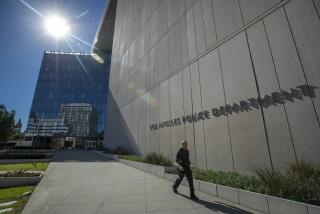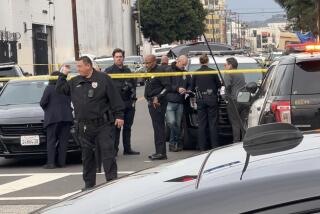Video of LAPD killing turns harsh light on skid row
It began like so many other arguments on the sorrowful pavement of Los Angeles’ skid row.
About half an hour before police fatally shot him Sunday, the man known to others on the streets as Africa sat outside the tent he had pitched on the sidewalk of San Pedro Street.
Video footage from a nearby building’s security camera captured the man, whose real name authorities have not yet released, yelling and gesturing angrily at another person in a tent alongside his own. Africa then strode over to the other man’s tent and flipped it off the curb and into the street.
Partially hidden from the camera’s view, Africa reached into the tent and appeared to scuffle with the man, who eventually limped away.
Whatever real or perceived slight had touched it off, the tussle set in motion a series of events that ended with police opening fire on the 39-year-old as he struggled with officers.
The killing, which millions of people viewed online after a witness uploaded video he recorded, has turned a sudden, harsh spotlight on the misery that plays out each day just east of the city’s downtown skyline where roughly 1,500 people sleep on the streets. Although it has underscored the acute challenges police face patrolling the tent encampments where mental illness and drug use run rampant, the incident has stoked long-simmering tensions and anger among skid row inhabitants and advocates who accuse police of being too quick to resort to heavy-handed, violent tactics.
LAPD Chief Charlie Beck, Mayor Eric Garcetti and other officials scrambled Monday to stay ahead of the wave of international attention brought on by the video of the shooting. With anti-police sentiments still running high throughout the country over several recent high-profile killings of unarmed black men, they were at pains to acknowledge the outpouring of anger but also portray Africa as the aggressor.
Calling the shooting “a tragedy” but “also a very intense situation and a brutal, brutal fight,” Beck said the incident began about noon Sunday when three officers and a supervisor responded to a robbery call on the 500 block of San Pedro.
The man, Beck said, “repeatedly refused to comply with officers’ commands and then began to fight with them.”
Two of the officers attempted to incapacitate the man using their Taser stun guns, but the devices “appeared to have little effect” as the man “continued to violently resist” police, according to Beck, who said the incident was captured by body cameras on two of the officers as well as on video filmed by witnesses.
As the officers struggled on the ground to subdue him, he “forcibly grabbed one of the officers’ holstered pistols,” Beck said.
That officer, Beck said, is a rookie with less than a year’s experience in the field. With the officer yelling repeatedly that “he has my gun!” two other officers and the supervisor, a sergeant, fired several rounds from close range. The man died on the sidewalk.
An examination afterward of the officer’s gun supported the claim that there had been a struggle for the weapon, Beck said. The gun’s slide had been partially pulled back and its magazine was dislodged from its resting place — indications, Beck said, “of a struggle over the weapon.”
Two of the officers involved in the struggle were injured. Both were treated and released, though Beck said one was at home recovering. The department has yet to identify the officers.
Enhanced and slowed by The Times for better clarity, the witness’ online video appears to show the man reaching up toward the officer’s waistband in the area of his holster. An officer can be heard on the recording’s audio making repeated comments about his gun, though his exact words are unclear.
The video from the nearby building’s security camera reviewed by The Times details the moments leading up to the shooting. The footage shows the officers speaking with a man for several minutes. At one point, two of the officers draw their Tasers, while the third motions for him to move against a wall. Instead, the man tries to climb into his tent. He resists forcefully and swings wildly at the officers as they attempt to pull him out of the tent.
Like the online video, the security footage shows the officers taking the man to the ground. One officer sits atop him striking him repeatedly in the head area while the others try to restrain the man. The security video does not clearly show whether the man reached for an officer’s gun.
One man who said he witnessed the shooting while walking to work on skid row disputed Beck’s account, telling The Times that he did not see the man try to grab an officer’s weapon.
“In the scuffle of him getting whooped like that, I don’t see how he could have been reaching for a gun,” said Lloyd Skannal, a cook at the Union Rescue Mission.
Beck said the officers involved were part of the Safer Cities Initiative — an LAPD task force specifically focused on skid row — and “are specially trained on dealing with homeless people and mental illness issues.” Some, he said, had undergone the department’s “most extensive mental illness training,” which he described as a 36-hour course.
That did little to assuage critics of the Safer Cities program, who have long argued that the department’s aggressive approach is counterproductive. They have called for strategies that focus more on providing treatment and basic services and housing for the homeless.
“As long as police are charged with moving, shaking and harassing people not to stay in camps, not to sleep on the park bench, we’re going to have huge tensions,” said Mollie Lowery, founder of LAMP Community, a respected skid row service provider. “The man shouldn’t have been on the sidewalk. He needs a society willing to provide mental health services on demand.”
The American Civil Liberties Union’s regional office called the killing avoidable and urged the Police Commission, which oversees the LAPD, to rethink how the department patrols skid row.
“It must take a hard look at the broader approach to policing in skid row — the deployment of officers, the strategies they employ, their relationship with the community, the patterns of use of force, and the training they are given to identify and deal with individuals with mental illness,” said Hector Villagra, the group’s executive director.
It will take several months before any decisions about the officers’ actions are made. After LAPD investigators re-create the shooting through evidence and witnesses’ statements, the Police Commission, which oversees the department, will ultimately decide whether the officers were justified in using deadly force. The district attorney’s office is also investigating the shooting.
David Winslow, an attorney representing the two officers and sergeant who fired their weapons, said the encounter “quickly turned into a life-or-death situation for the officers.”
“They did everything they could to persuade the suspect to cooperate. And when they attempted to take him into custody, he started a violent attack,” Winslow said.
At the site of the shooting, a lone orange tent stood near a tree Monday with a memorial that included two candles. A police car pulled up to the site.
“Murderers!” one man shouted at the cruiser.
Although Africa’s real name was a mystery even to other homeless people who considered him a friend, a portrait emerged Monday of a troubled man who showed a kind, gentle side that sometimes warred with a volatile, angry one. Coroner’s officials Monday were still trying to identify and locate the man’s family.
Some who knew him said he had been living on skid row for about a year and had told them he had arrived after spending several years in a mental health facility.
Andy Bales, president of Union Rescue Mission, a skid row mainstay, said Africa “helped mission employees clean up every day.” The man, however, sometimes acted out, Bales said. He recounted a day when Africa “came flying out of his tent” and knocked some items out of a passerby’s hands.
A man who identified himself as Juju said he was friends with Africa, whom he also sometimes called Cameroon, after the country that Africa said was his home. Juju recalled the man’s frequent run-ins with police, who often ordered him to take down his tent.
“He would say, ‘Ticket me. Give me my day in court,’ ” Juju said.
He was a peaceful man, Juju said. Once, when Juju’s tent was stolen, Africa lent him blankets and made sure he had food.
“He was generous,” Juju said. “He lived in a tent, but he was content.”
Times staff writers Angel Jennings, Sarah Parvini, Catherine Saillant and Richard Winton contributed to this report.
More to Read
Start your day right
Sign up for Essential California for news, features and recommendations from the L.A. Times and beyond in your inbox six days a week.
You may occasionally receive promotional content from the Los Angeles Times.









